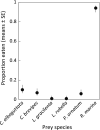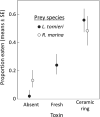Choosy cannibals: Targeted consumption of conspecific hatchlings by larval cane toads is triggered by species-specific defensive toxins
- PMID: 35261745
- PMCID: PMC8888257
- DOI: 10.1002/ece3.8655
Choosy cannibals: Targeted consumption of conspecific hatchlings by larval cane toads is triggered by species-specific defensive toxins
Abstract
In many species, cannibalism is uncommon and involves nonselective consumption of conspecifics as well as heterospecifics. However, within their invasive Australian range, cane toad larvae (Rhinella marina) specifically target and voraciously consume the eggs and hatchlings of conspecifics, often extirpating entire clutches. In contrast, toad larvae rarely consume the eggs and hatchlings of native frogs. Here, we use laboratory studies to demonstrate that this selective consumption is triggered by species-specific chemical cues: maternally-invested bufadienolide toxins that otherwise defend cane toad eggs and hatchlings against predators. We find that these cues stimulate feeding behaviors in toad tadpoles, such that the addition of bufadienolide toxins to the water column increases predation on eggs, not only of conspecifics, but also of native anuran species that are otherwise usually ignored. In contrast, we find that cannibalism rates on conspecific hatchlings are high and unaffected by the addition of bufadienolide cues. The maternally-invested toxins present in conspecific eggs may therefore be more easily detected post-hatching, at which point tadpole feeding behaviors are induced whether or not additional toxin cues are present. As bufadienolide cues have previously been found to attract toad tadpoles to vulnerable hatchlings, our present findings demonstrate that the same toxin cues that attract cannibalistic tadpoles also induce them to feed, thereby facilitating cannibalism through multiple behavioral effects. Because native fauna do not produce bufadienolide toxins, the species specificity of these chemical cues in the Australian landscape may have facilitated the evolution of targeted (species-specific) cannibalism in invasive cane toad populations. Thus, these bufadienolide toxins confer cost (increased vulnerability to cannibalism in early life-stages) as well as benefit (reduced vulnerability to predation by other taxa).
Keywords: Anura; Bufo marinus; behavior; chemical communication; embryonic development; intraspecific predation; ovivory; pheromone.
© 2022 The Authors. Ecology and Evolution published by John Wiley & Sons Ltd.
Conflict of interest statement
There are no conflicts of interest.
Figures



Similar articles
-
Tadpole Skin Secretions, Not Food or Temperature, Mediate Costly Cannibal-Induced Plasticity in Invasive Cane Toad Hatchlings.Ecol Evol. 2025 Mar 30;15(4):e71094. doi: 10.1002/ece3.71094. eCollection 2025 Apr. Ecol Evol. 2025. PMID: 40170807 Free PMC article.
-
A biological invasion reduces rates of cannibalism by Japanese toad tadpoles.Sci Rep. 2023 Jun 13;13(1):9587. doi: 10.1038/s41598-023-36743-8. Sci Rep. 2023. PMID: 37311915 Free PMC article.
-
The Effects of Conspecific Alarm Cues on Larval Cane Toads (Rhinella marina).J Chem Ecol. 2019 Oct;45(10):838-848. doi: 10.1007/s10886-019-01111-2. Epub 2019 Nov 1. J Chem Ecol. 2019. PMID: 31677136
-
The ecological impact of invasive cane toads (Bufo marinus) in Australia.Q Rev Biol. 2010 Sep;85(3):253-91. doi: 10.1086/655116. Q Rev Biol. 2010. PMID: 20919631 Review.
-
The things they carried: The pathogenic effects of old and new parasites following the intercontinental invasion of the Australian cane toad (Rhinella marina).Int J Parasitol Parasites Wildl. 2016 Dec 29;6(3):375-385. doi: 10.1016/j.ijppaw.2016.12.001. eCollection 2017 Dec. Int J Parasitol Parasites Wildl. 2016. PMID: 30951567 Free PMC article. Review.
Cited by
-
Tadpole Skin Secretions, Not Food or Temperature, Mediate Costly Cannibal-Induced Plasticity in Invasive Cane Toad Hatchlings.Ecol Evol. 2025 Mar 30;15(4):e71094. doi: 10.1002/ece3.71094. eCollection 2025 Apr. Ecol Evol. 2025. PMID: 40170807 Free PMC article.
-
A biological invasion reduces rates of cannibalism by Japanese toad tadpoles.Sci Rep. 2023 Jun 13;13(1):9587. doi: 10.1038/s41598-023-36743-8. Sci Rep. 2023. PMID: 37311915 Free PMC article.
-
Intraspecific interference retards growth and development of cane toad tadpoles, but those effects disappear by the time of metamorphosis.R Soc Open Sci. 2023 Nov 8;10(11):231380. doi: 10.1098/rsos.231380. eCollection 2023 Nov. R Soc Open Sci. 2023. PMID: 38026033 Free PMC article.
-
Mechanisms, costs, and carry-over effects of cannibal-induced developmental plasticity in invasive cane toads.Ecol Evol. 2024 Feb 9;14(2):e10961. doi: 10.1002/ece3.10961. eCollection 2024 Feb. Ecol Evol. 2024. PMID: 38343578 Free PMC article.
References
-
- Alford, R. A. , Cohen, M. P. , Crossland, M. R. , Hearnden, M. N. , & Schwarzkopf, L. (1995). Population biology of Bufo marinus in northern Australia. In Finlayson C. M. (Ed.), Wetland research in the wet‐dry tropics of Australia (pp. 173–180). Supervising Scientist Report 101, Canberra, Australia.
-
- Babbitt, K. J. , & Meshaka, W. E. Jr (2000). Benefits of eating conspecifics: Effects of background diet on survival and metamorphosis in the Cuban treefrog (Osteopilus septentrionalis). Copeia, 2000(2), 469–474.
-
- Caldwell, J. P. , & de Araujo, M. C. (1998). Cannibalistic interactions resulting from indiscriminate predatory behavior in tadpoles of Poison Frogs (Anura: Dendrobatidae). Biotropica, 30(1), 92–103.
Associated data
LinkOut - more resources
Full Text Sources
Other Literature Sources
Research Materials

